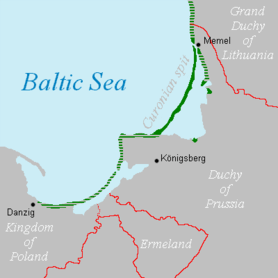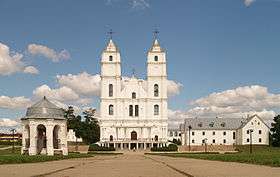Latvians
Latvians (Latvian: latvieši; Livonian: lețlizt) are a Baltic ethnic group and nation native to Latvia and the immediate geographical region, the Baltics. They are occasionally also referred to as Letts,[39][40] although this term is becoming obsolete. Latvians share a common Latvian language, culture and history.
latvieši | |||||||||||||||||||||||||||||||||||||||||||||||||||||
|---|---|---|---|---|---|---|---|---|---|---|---|---|---|---|---|---|---|---|---|---|---|---|---|---|---|---|---|---|---|---|---|---|---|---|---|---|---|---|---|---|---|---|---|---|---|---|---|---|---|---|---|---|---|
 Participants of the Latvian Song and Dance Festival in Latvian folk costumes | |||||||||||||||||||||||||||||||||||||||||||||||||||||
| Total population | |||||||||||||||||||||||||||||||||||||||||||||||||||||
c. 1.6–1.7 million
 | |||||||||||||||||||||||||||||||||||||||||||||||||||||
| Regions with significant populations | |||||||||||||||||||||||||||||||||||||||||||||||||||||
| 102,000 (2014)[2][3] | |||||||||||||||||||||||||||||||||||||||||||||||||||||
| 96,070–102,000 (2009)[4] | |||||||||||||||||||||||||||||||||||||||||||||||||||||
| 27,870 (2006)[5] | |||||||||||||||||||||||||||||||||||||||||||||||||||||
| 27,752 (2014)[6] | |||||||||||||||||||||||||||||||||||||||||||||||||||||
| 25,000 (2002)[7][8][9] | |||||||||||||||||||||||||||||||||||||||||||||||||||||
| 20,593 (2011)[10] | |||||||||||||||||||||||||||||||||||||||||||||||||||||
| 20,509 (2016)[11] | |||||||||||||||||||||||||||||||||||||||||||||||||||||
| 20,068 (2010) | |||||||||||||||||||||||||||||||||||||||||||||||||||||
| 20,000 (2004)[12] | |||||||||||||||||||||||||||||||||||||||||||||||||||||
| |||||||||||||||||||||||||||||||||||||||||||||||||||||
| Languages | |||||||||||||||||||||||||||||||||||||||||||||||||||||
| Latvian | |||||||||||||||||||||||||||||||||||||||||||||||||||||
| Religion | |||||||||||||||||||||||||||||||||||||||||||||||||||||
| Predominantly Lutheranism,[38] with Roman Catholic, Latvian Orthodox minorities | |||||||||||||||||||||||||||||||||||||||||||||||||||||
| Related ethnic groups | |||||||||||||||||||||||||||||||||||||||||||||||||||||
| Other Balts | |||||||||||||||||||||||||||||||||||||||||||||||||||||
History
A Finnic-speaking tribe known as the Livs settled among the Latvians and modulated the name to "Latvis", meaning "forest-clearers", which is how medieval German, Teutonic settlers also referred to these peoples. The Germanic settlers referred to the natives as "Letts" and the nation to "Lettland", naming their colony Livonia or Livland.
The Latin form, Livonia, gradually referred to the whole territory of modern-day Latvia as well as southern Estonia, which had fallen under a minimal Germanic influence. Latvians and Lithuanians are the only surviving members of the Baltic branch of the Indo-European family.
Genetics
Paternal haplogroups R1a and N1a1-Tat are the two most frequent, reaching 39.9% each among ethnic Latvians.[41] R1a has originated in eastern Europe and is associated with spread of Indo-European languages. R1a of Latvians is predominantly M558 and compared to other populations also has the highest concentration of M558 among R1a. N1a1-Tat mutation originated in East Asia and had spread through the Urals into Europe where it is currently most common among Finno-Ugric and Baltic people. Latvians and Lithuanians have a predominance of the L550 branch of N1a1-Tat.
Culture
Influences

Latvians share a common language and have a unique culture with traditions, holidays, customs and arts. The culture and religious traditions have been somewhat influenced by Germanic, Scandinavian, and Russian traditions. Latvians have an ancient culture that has been archaeologically dated back to 3000 BC. Latvians maintained a considerable connection and trade with their neighbors. The first indications of human inhabitants on the lands of modern Latvia date archaeologically to c. 9000 BC, suggesting that the first settlers were hunters that stayed almost immediately following the end of the last Ice Age. Colonizers from the south arrived quickly, driving many of the hunters northward as polar ice caps melted further, or east, into modern-day Russia, Belarus, and Ukraine. The Roman author Tacitus remarked upon the "Aestii" peoples, thought to be inhabitants of the modern Baltic lands, suggesting that they were abound with formidable, yet peaceful and hospitable people. The Latvian peoples remained relatively undisturbed until Papal intervention via the Germanic, Teutonic Order colonized Kurzeme (Courland in English, Kurland in German), beginning in the first half of the 13th century. Papal decrees ordered the Teutonic Order to spread the "Word of the Lord" and the Gospel of Christianity throughout "uncivilized", "Pagan lands". Though these attempts to Christianize the population failed, and the Teutonic Order eventually redeployed southward, to the region of what was once known as East Prussia.
South-Eastern Latvia (Latgale), due to having a relatively large ethnic Russian population, has maintained a large Russian influence.
Religion

Paganism was the main religion before territory of Latvia was invaded by Christian Teutonic Order. Latvians still celebrate traditional feasts (solstices). Dievturība is a neopagan movement which claims to be a modern revival of the ethnic religion of the Latvians before Christianization in the 13th century.
Most of the Christian Latvians belong to the Evangelical Lutheran Church, but in Latgale and Alsunga Municipality the Roman Catholic Church is predominant, a small minority of Latvians belong to the Latvian Orthodox Church and other religious congregations.[38] In the late 18th century, a small but vibrant Herrnhutist movement played a significant part in the development of Latvian literary culture before it was absorbed into the mainstream Lutheran denomination.
Language
Latvians' ancestral language, Latvian, has been recorded since at least the 16th century.[42] It developed into a distinct language by the 9th century. It is part of a distinct linguistic branch of Indo-European languages: the Baltic languages.
Another notable language of Latvia is the nearly extinct Livonian language of Baltic-Finnic sub-branch of Uralic language family, which enjoys protection by law. The Latgalian language (a dialect of Latvian) is also protected by Latvian law as historical variation of Latvian language.
See also
References
- "ISG08. Latviešu skaits Latvijā un Rīgā gada sākumā". Data.csb.gov.lv. Retrieved 2017-08-02.
- Population by country of birth and nationality, Annual Population Survey, Office of National Statistics, 2014] Archived August 28, 2010, at the Wayback Machine
- BNS. "TVNET :: Ārvalstīs - Lielbritānijā pašlaik dzīvo 39 tūkstoši viesstrādnieku no Latvijas". Tvnet.lv. Retrieved 2011-12-03.
- "U.S. Census website". United States Census Bureau. Retrieved 2011-12-03.
- contenu, English name of the content author / Nom en anglais de l'auteur du. "English title / Titre en anglais". 12.statcan.gc.ca. Retrieved 2 August 2017.
- "Federal Statistical Office - Foreign population by average-age and average duration of residence". Destatis.de. 2008-10-20. Retrieved 2012-01-23.
- "Um atalho para a Europa". Epoca. Editora Globo S.A. 24 June 2002. Archived from the original on 21 August 2012.
- "Brazilian Embassy in Stockholm". Brazilianembassy.se. Archived from the original on 4 January 2007. Retrieved 2 August 2017.
- "A Millenarian Migration: Varpa". Lituanus.org. Retrieved 2 August 2017.
- "CSO Emigration" (PDF). Census Office Ireland. Retrieved January 29, 2013.
- ABS. "ABS Statistics". Stat.data.abs.gov.au. Retrieved 2 August 2017.
- Archived 2006-02-20 at the Wayback Machine
- "Immigrants and Norwegian-born to immigrant parents, by country background. 1 January 2019". Statistics Norway (in Norwegian).
- https://www.scb.se/hitta-statistik/statistik-efter-amne/befolkning/befolkningens-sammansattning/befolkningsstatistik/pong/tabell-och-diagram/helarsstatistik--riket/befolkning-efter-fodelseland-och-ursprungsland/
- "State statistics committee of Ukraine - National composition of population, 2001 census". 2001.ukrcensus.gov.ua (in Ukrainian). p. 3. Retrieved 2017-08-02.
- "StatBank Denmark". Statbank.dk. Retrieved 2 August 2017.
- "Población extranjera por sexo, edad (grupos quinquenales) y país de nacionalidad". Ine.es. Retrieved 2 August 2017.
- "Population by ethnic nationality". Statistics Estonia. Retrieved 30 March 2016.
- "Statistiche demografiche ISTAT". Demo.istat.it. Retrieved 2015-06-28.
- "Language by sex, by region and municipality in 1990 to 2017". Pxweb2.stat.fi. Retrieved 2011-12-03.
- https://www.diplomatie.gouv.fr/fr/dossiers-pays/lettonie/presentation-de-la-lettonie/
- Archived December 21, 2011, at the Wayback Machine
- "Gyventojų skaičius metų pradžioje. Požymiai: tautybė - Rodiklių duomenų bazėje". Db1.stat.gov.lt. Archived from the original on 2012-09-06. Retrieved 2011-12-03.
- "Demografie van de allochtonen in Nederland" (PDF). Cbs.nl. Retrieved 2017-08-02.
- Ethnic composition, religion and language skills in the Republic of Kazakhstan Archived 2011-07-23 at the Wayback Machine
- "Archived copy" (PDF). Archived from the original (PDF) on 2016-03-03. Retrieved 2015-03-18.CS1 maint: archived copy as title (link)
- "Bevolking per nationaliteit, geslacht, leeftijdsgroepen op 1/1/2008" (in Dutch). Statbel.fgov.be. Archived from the original on 2011-11-20. Retrieved 2011-12-03.
- "Frontpage - Hagstofa". Hagstofa. Retrieved 2 August 2017.
- "Archived copy" (PDF). Archived from the original (PDF) on 2013-11-06. Retrieved 2013-04-21.CS1 maint: archived copy as title (link)
- "Latvijas Republikas un Venecuēlas Bolivāra Republikas divpusējās attiecības". Mfa.gov.lv. Retrieved 2 August 2017.
- "Ludnosc Stan i struktura demograficzno-spoteczna" (PDF). Stat.gov.pl. Retrieved 2017-08-02.
- Archived 2011-07-18 at the Wayback Machine
- "Archived copy" (PDF). Archived from the original (PDF) on 2015-07-22. Retrieved 2014-11-13.CS1 maint: archived copy as title (link)
- "Archived copy" (PDF). Archived from the original (PDF) on 2011-05-30. Retrieved 2011-07-24.CS1 maint: archived copy as title (link)
- "1. POPULATION BY ETHNICITY – DETAILED CLASSIFICATION, 2011 CENSUS". Croatian Bureau of Statistics. Retrieved 2017-05-12.
- "Tieslietu ministrijā iesniegtie reliģisko organizāciju pārskati par darbību 2011. gadā" (in Latvian). Archived from the original on 2012-11-26. Retrieved 2012-07-25.
- "Lett - definition of Lett in English - Oxford Dictionaries". Oxford Dictionaries - English. Retrieved 2 August 2017.
- "Definition of LETT". Merriam-webster.com. Retrieved 2 August 2017.
- "Y Chromosome and Mitochondrial DNA Variation in Lithuanians" (PDF). Archived from the original (PDF) on 2009-02-25. Retrieved 2010-05-20. Kasperaviciute et al. 2004 (link broken)
- Vīksniņš, Nicholas (1973). "The Early History of Latvian Books". Lituanus. 19 (3). Retrieved 3 September 2019.
External links
| Wikisource has the text of the 1911 Encyclopædia Britannica article Lithuanians and Letts. |
- Latvia. Lettish Life in Legendary & Modern Times by Florence Farmborough. In: Peoples of All Nations: Their Life Today and Story of Their Past. Vol 5 – pp. 3267-3296 (first published in 1920)
